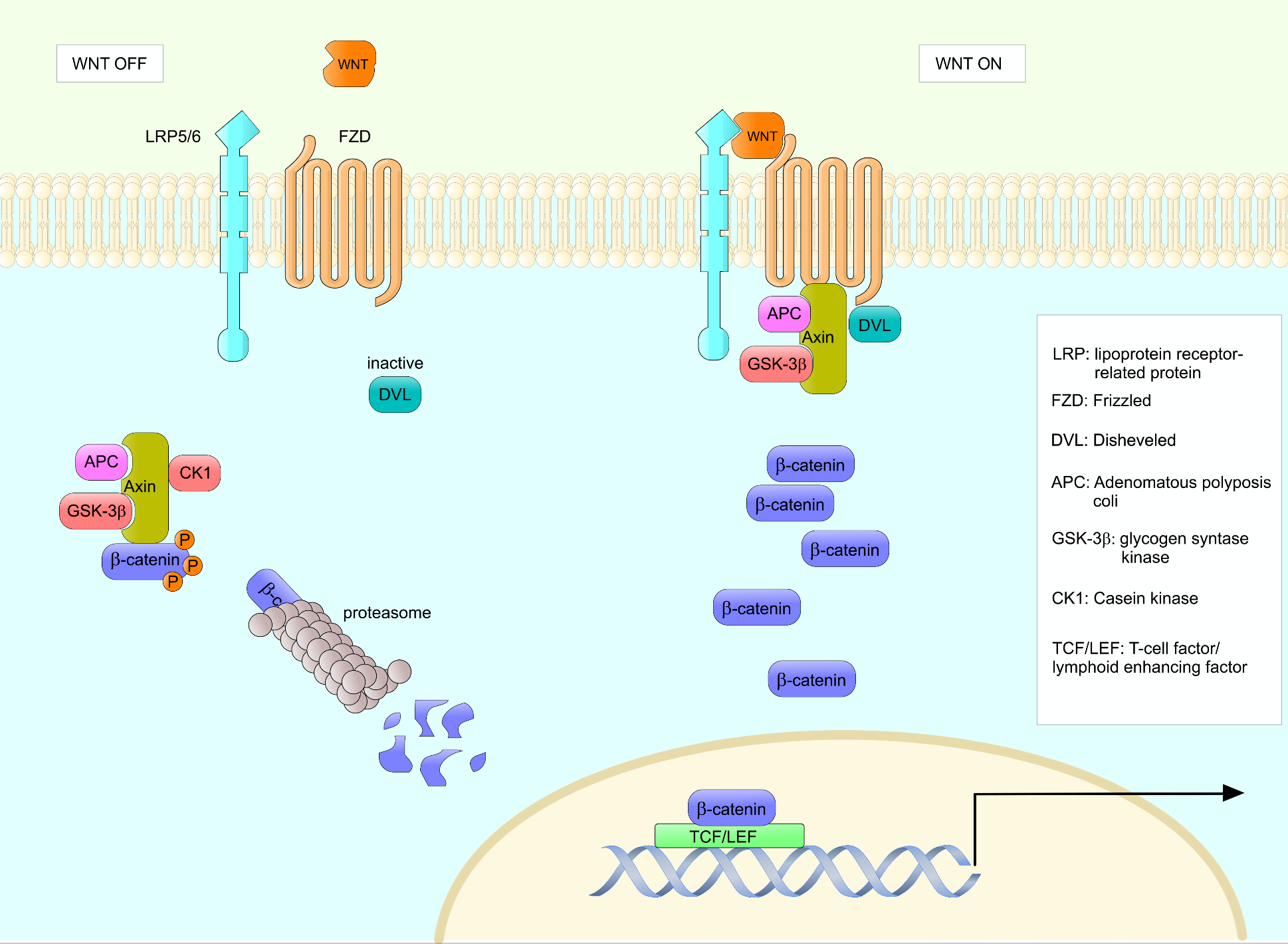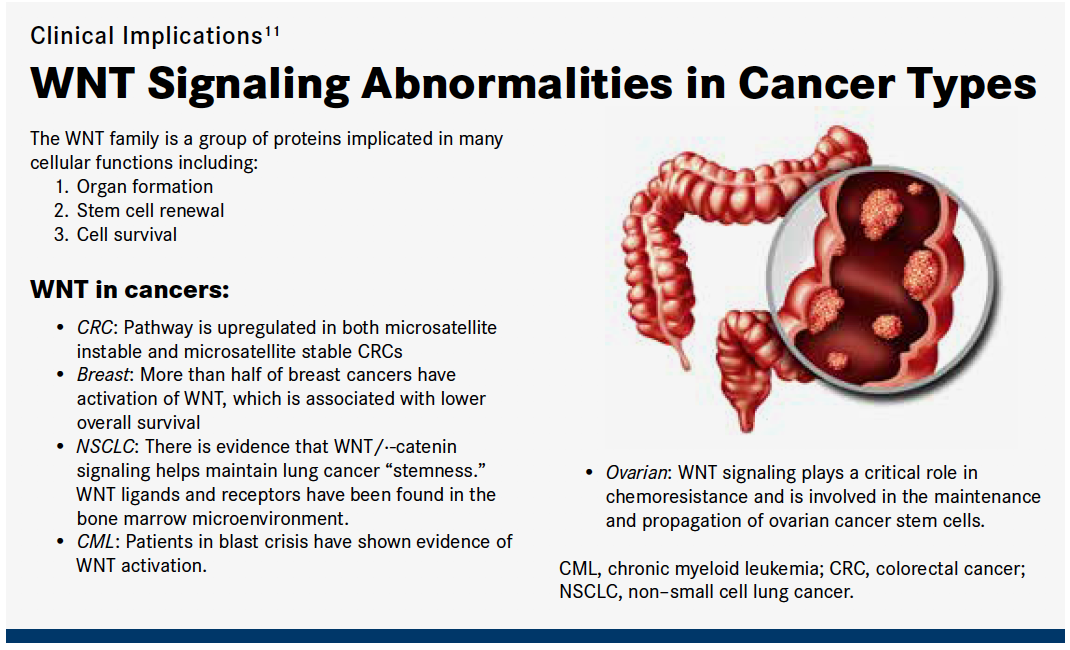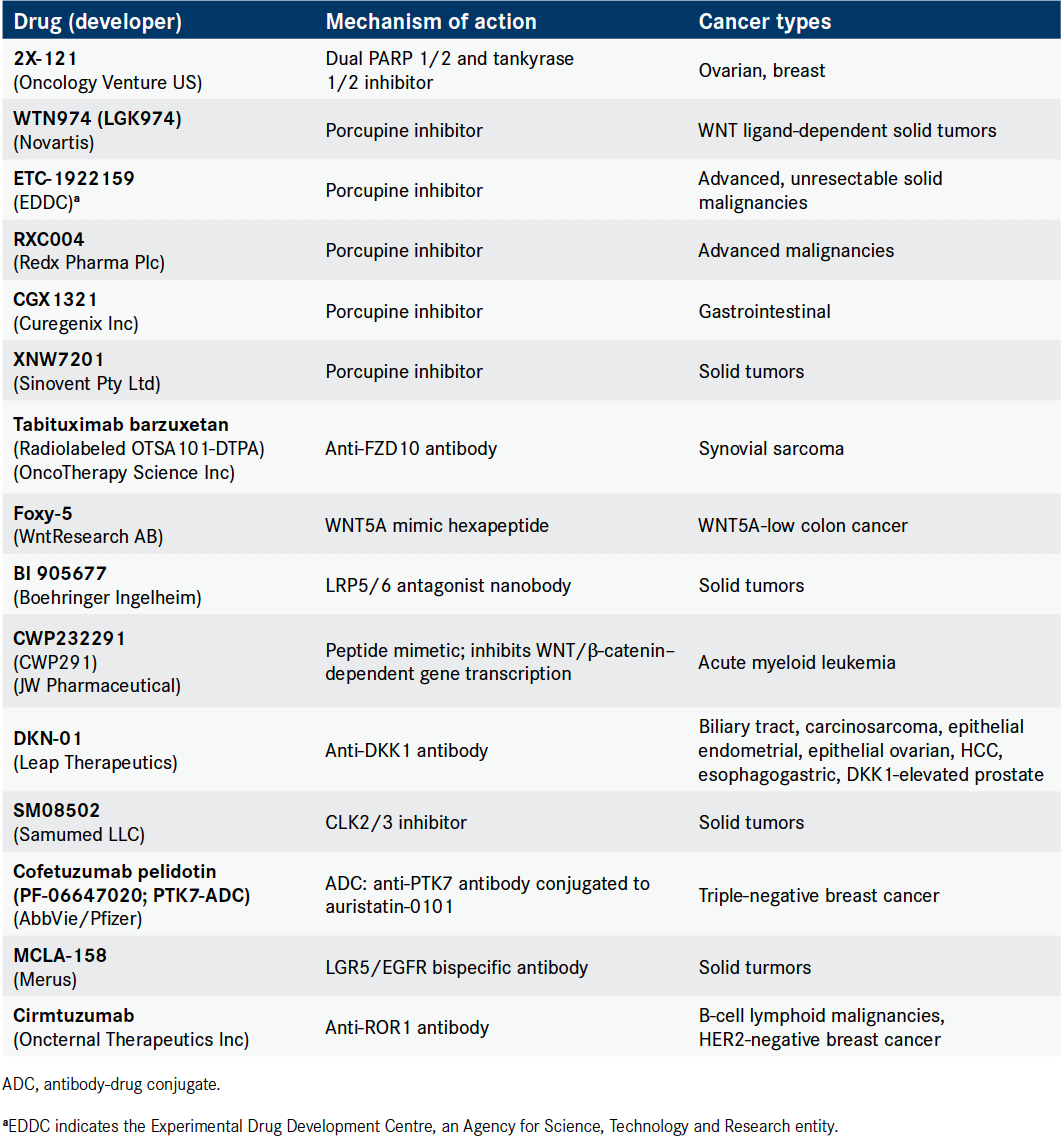Publication
Article
Oncology Live®
Hard-to-Target WNT Pathway Gets a Fresh Look in Oncology
Author(s):
Investigators continue to find innovative ways to attack the WNT pathway beyond targeting the major molecular players.
Research interest in targeting the WNT pathway, a critical regulator of embryonic development and adult tissue homeostasis, has ebbed and flowed in the almost 40 years since its discovery.1,2 Yet finding the right balance between efficacy and safety has thus far proved elusive, and the field is littered with failures.2
The pull remains strong, however, and investigators continue to find innovative ways to attack the WNT pathway beyond targeting the major molecular players. Myriad drugs with varied mechanisms of action are currently in the pipeline but are still in the early stages of clinical development (Table).
Investigators recently uncovered a potential role for WNT signaling in immune evasion by cancer cells.3-5 Activation of WNT signaling is enriched in tumors with low levels of infiltrating T cells.5 This raises the possibility that WNT inhibitors could make immunologically cold tumors more responsive to immunotherapy. Drug developers are seeking to capitalize on this link through combination therapy with immune checkpoint inhibitors.
DKN-01, an antibody targeting the WNT pathway inhibitor DKK1 (dickkopf-related protein 1), has been shown to participate in innate immunity.6 The combination of DKN-01 and the PD-1 inhibitor pembrolizumab (Keytruda) has recently showed promise in patients with gastroesophageal adenocarcinoma who had high DKK1 expression.7 DKN-01 is being tested in numerous clinical trials across a range of malignancies.
A Complex Network
The first mammalian WNT gene was described in 1982.1 In the intervening years, painstaking research has painted a picture of the WNT genes—19 of which have now been identified—as orchestrators of an evolutionarily conserved and highly complex pathway that plays a fundamental role in embryonic development and the maintenance of many adult tissues.8-12
Figure. Canonical View of WNT Signaling9-12

WNTs serve as ligands for a family of 10 Frizzled (FZD) receptors. Although certain ligands have a higher affinity for particular receptors, in general they are highly promiscuous in their binding.12 Receptor-ligand interaction triggers the membrane recruitment and activation of disheveled (DVL), which relays WNT signals from the cell surface to intracellular downstream effectors.9-12
Beyond this basic outline of WNT signal transduction, variations in several key molecular components mark the existence of several different WNT signaling cascades with distinct cellular outcomes. The best characterized of these cascades is dubbed the canonical, or β-catenin–dependent, pathway (Figure 9-12). In the absence of WNT ligands, β-catenin is retained in the cytoplasm by a multiprotein complex composed of axin, adenomatous polyposis coli (APC), GSK3β and CK1α. This aptly named “destruction complex” phosphorylates the β-catenin protein, ultimately targeting it for degradation by the proteasome.9-12
The canonical pathway is activated upon WNT ligand binding to FZD and its coreceptor LRP5/6, which leads to inhibition of the destruction complex. Thus spared from phosphorylation and degradation, β-catenin is stabilized and subsequently moves into the nucleus, where it interacts with TCF/LEF transcription factors to drive transcription of WNT target genes, which coordinate a plethora of cellular functions.9-12
Two main noncanonical WNT pathways have also been characterized; in addition to being β-catenin independent, they involve coreceptors and downstream signaling mediators that differ from those implicated in the canonical pathway. The WNT/planar cell polarity (PCP) pathway involves coreceptors such as ROR1 and PTK7, as well as downstream signaling by Rho GTPases and JNK, and plays key roles in cell division, morphology, and migration.
Cancers Associated With Aberrant WNT Activity
Owing to their pleiotropic functions in key cellular processes, both canonical and noncanonical forms of WNT signaling have been implicated in carcinogenesis, although the role of the former is better understood.9-12 Its best known association with cancer is through mutations in the APC gene, which occur in more than 80% of colorectal carcinomas (CRCs) and are associated with familial adenomatous polyposis, a hereditary cancerous condition that takes its name from the gene.12
A 2012 report from The Cancer Genome Atlas Research Network estimated that up to 93% of sporadic CRCs contain at least 1 alteration in a known WNT pathway component.13 Beyond APC mutations, other abnormalities in WNT signaling include mutations in RNF43 and gene fusions involving RSPO family members, which encode proteins that regulate FZD degradation. RNF43 mutations and RSPO fusions are found in approximately 18% and 10% of CRCs, respectively.11,14,15
WNT signaling abnormalities have been found across a range of other cancer types and in a variety of pathway components. An estimated 25% to 35% of hepatocellular carcinomas (HCCs) and more than half of breast cancers, for example, display heightened activity of the WNT pathway.11,16 The basal-like breast cancer subtype seems to be particularly susceptible, and WNT pathway activation has been shown to be associated with poorer prognosis.17
A Double-Edged Sword
WNT’s central role in many cellular processes, including those underlying hallmarks of malignant transformation, has led to substantial interest in targeting the pathway. Investigators have evaluated a host of drugs with different mechanisms of action, and several have entered clinical trials. Hampered by significant toxicity or lack of efficacy, however, none have made it past the early stages of clinical development.2
Efforts to target the major molecular players have yielded several anticancer drugs. OncoMed Pharmaceuticals began developing the anti-FZD1/2/5/7/8 antibody vantictumab and ipafricept, a fusion protein comprising a truncated FZD8 fused to the Fc region of immunoglobulin G1 that was designed to act as a decoy receptor for WNT ligands.10 Bayer pulled out of a licensing deal for the 2 drugs in 2017, and no clinical trials are ongoing for either agent.18

Phase 1 clinical trials of vantictumab and ipafricept were recently terminated prematurely because of concerns about bone toxicity,19,20 a common on-target toxic effect of inhibiting the WNT pathway, which plays a critical role in normal bone homeostasis.21 In a phase 1b study in 26 patients with untreated metastatic pancreatic cancer (NCT02050178), ipafricept in combination with nab-paclitaxel (Abraxane) and gemcitabine was well tolerated, with no dose-limiting toxicities (DLTs) or fragility fractures, and 34.6% of patients had partial responses (PRs).
Tabituximab barzuxetan (OTSA101-DTPA- 90Y) is an anti-FZD10 antibody radiolabeled with yttrium 90 that investigators are testing in patients with synovial sarcoma, in which FZD10 is frequently found to be overexpressed.22 In a first-in-human study (NCT01469975), the best response in 3 of 8 patients treated with tabituximab barzuxetan was stable disease (SD), which lasted up to 21 weeks for 1 patient. That trial was halted because of slow accrual, but a similar study is ongoing (NCT04176016).23
Several β-catenin inhibitors have also been developed. PRI-724 and CWP232291 (CWP291) block the interaction between β-catenin and its transcriptional coactivator CREB-binding protein to prevent WNT target gene transcription.10,24 Ongoing development of these drugs as anticancer agents is somewhat unclear. CWP291 in combination with cytarabine is undergoing phase 1/2 clinical testing in patients with relapsed/refractory acute myeloid leukemia (NCT03055286), with anticipated study completion in October 2020.
Noncanonical Signaling
Research has further revealed the complexities of WNT signal transduction, clarifying that some components have tumor-suppressive rather than tumor-promoting effects, depending on the context. One example is WNT5A, which has been shown to play a protective role in several tumor types.25
Foxy-5 is a novel hexapeptide molecule that mimics WNT5A and binds to and activates FZD2 and FZD5 to restore WNT5A function in tumors with low expression level.25 Investigators have conducted 2 clinical trials in patients with breast, colon, or prostate cancer (NCT02020291, NCT02655952), but no results have been released to date. A phase 2 study of Foxy-5 as neoadjuvant treatment for patients with WNT5A-low colon cancer is ongoing (NCT03883802).
Also notable is that WNT5A functions in the noncanonical WNT pathway. Several other novel drugs have also been designed to target coreceptors involved in the WNT/ PCP pathway, ROR1 and PTK7.
Cirmtuzumab is an anti-ROR1 antibody that has demonstrated promise in preclinical trials. Cirmtuzumab functioned synergistically with the Bruton tyrosine kinase inhibitor ibrutinib (Ibrance) to reduce tumor cell proliferation in cells and xenografts derived from patients with chronic lymphocytic leukemia (CLL).26
Data from a phase 1/2 study (NCT03088878) of the combination showed an overall response rate (ORR) of 67%, with 1 confirmed complete response (CR) with no morphologic evidence of CLL in the marrow, 1 clinical CR, and 6 PRs.27 Following this success, investigators opened an expansion cohort to include patients with mantle cell lymphoma. Interim data demonstrated a 50% CR rate in evaluable patients (n = 12). Notably, 4 patients achieved PR and 2 had stable disease (SD). The best ORR was 83%.28
Table. Novel Agents Targeting WNT Pathway in Development

Cofetuzumab pelidotin (PF-06647020) is an antibody-drug conjugate comprising a PTK7-targeted antibody linked to an auristatin payload. In a phase 1 study (NCT02222922), 112 patients with advanced solid tumors were treated at doses ranging from 0.2 to 3.7 mg/kg. Investigators noted 2 DLTs at the 3.7-mg/kg dose, and the recommended phase 2 dose was 2.8 mg/kg. Most AEs were grade 1 or 2, most commonly nausea, alopecia, and fatigue. The ORR was 27% in patients with ovarian cancer (n = 44), 16% in patients with non–small cell lung cancer (n = 25), and 21% in those with triple-negative breast cancer (n = 29).29
Additional Targets
DKN-01
Investigators presented results from the phase 1 P102/KEYNOTE-731 (NCT02013154) study of DKN-01 in combination with pembrolizumab at the 2020 Gastrointestinal Cancers Symposium.7 To date, 34 patients with gastroesophageal adenocarcinoma had been enrolled. Among the 10 response evaluable patients with high DKK1 expression levels, the ORR was 50% (all PRs), and the disease control rate (DCR) was 80%. In contrast, patients with low DKK1 expression levels (n = 15) had an ORR of 0% and a DCR of 20%.7
DKN-01 also recently showed promise in a phase 2 basket trial in patients with endometrial or ovarian cancer, both as monotherapy and in combination with paclitaxel (NCT03395080).30
In a pooled analysis of all patients treated with DKN-01 monotherapy (n = 51), 21.6% of patients had WNT activating mutations and demonstrated a longer median PFS (168 vs 56 days) as compared to patients without WNT activating mutations. Median OS was not reached in the WNT activating mutation group versus 328 days in the non-WNT activating mutation group.
Further, DKK1 high expression was associated with WNT activating mutations and was associated with greater clinical benefit in patients treated with monotherapy. RNAscope expression data was available for 32 of the 51 patients treated with monotherapy. Patients with DKK1-high tumors (n = 7) experienced longer PFS (168 vs 56 days) and OS (450 vs 276 days) compared with those who had DKK1-low tumors (n = 25) per RNAscope assay results.30
In total, 54 patients were treated with DKN-01 plus paclitaxel. The combination generated robust response in patients with paclitaxel-experienced endometrioid endometrial cancer (n = 22). Twelve patients had SD and 10 had progressive disease (PD). In 6 evaluable pretreated carcinosarcoma patients, 2 patients achieved partial response, 1 had SD, and 3 had PD.30
Porcupine Enzymes
Another focus has been on the development of porcupine (PORCN) inhibitors. PORCN is an enzyme involved in the posttranslational modification of WNT ligands, which is essential for WNT secretion. As such, PORCN inhibitors should cause a complete shutdown of all WNT signaling.10
Five PORCN inhibitors are currently in clinical testing (Table). WNT974, a firstin-class, selective, oral PORCN inhibitor, demonstrated preclinical activity as monotherapy in patients with solid tumors when evaluated based on AXIN2 suppression, a marker of WNT pathway activity.31 Updated data from the phase 1 trial’s combination arm (NCT01351103) were presented at the 2020 American Association for Cancer Research Annual Meeting. WNT974 plus spartalizumab, an anti–PD-1 monoclonal antibody, were well tolerated and demonstrated similar efficacy as the monotherapy with evidence of PORCN inhibition at all dose levels.32
At data cutoff, of the 27 patients enrolled, 24 discontinued (18 due to disease progression), and 3 remained on treatment. The most common tumor types were nonuveal melanoma (n = 8), triple-negative breast cancer (n = 7), and uveal melanoma (n = 5). WNT974 was administered in 28-day cycles (2.5-10.0 mg orally daily, days 1-8 or 1-15 of cycles 1 or 1-4); spartalizumab was dosed intravenously at 400 mg every 4 weeks.
Seventy-eight percent of patients experienced a treatment-related AE, the most common being hypothyroidism (19%). Four patients (15%) had 7 suspected-related grade 3/4 AEs—arthralgia, atrial fibrillation, diabetes mellitus, diabetic ketoacidosis, hyperglycemia, hyponatremia, and maculopapular rash.
Eleven patients (41%) had SD, 13 (48%) had PD, and response was unkown in 2 (7%). Of the 17 patients who were previously treated with anti–PD-1 therapy, 9 (53%) reported SD and 4 remained on study for more than 24 weeks. Further, all patients with uveal melanoma had SD.32
SM08502
SM08502 is an inhibitor of CLK2/3, proteins that play a role in RNA splicing. Alternative splicing is an important mechanism to regulate the expression of WNT-related genes; thus, CLK2/3 inhibition offers a way to indirectly target the WNT pathway.33
Potent inhibition of tumor growth was observed in xenograft mouse models treated with SM08502 alone (gastrointestinal cancer) or in combination with standard-of-care chemotherapy (pancreatic cancer),33,34 and the FDA has granted SM08502 an orphan drug designation for the treatment of pancreatic cancer.35 Results from a phase 1 study in advanced solid tumors (NCT03355066) are eagerly awaited.
PARP
Oncology Venture is developing 2X-121, a dual inhibitor of the PARP 1 and 2 proteins as well as PARP family members tankyrases 1 and 2, known alternatively as PARP5A and 5B, respectively. Tankyrase enzymes increase the degradation of axin by the proteasome.36 In a phase 1 study (NCT01618136) in 41 patients with advanced solid tumors treated at 6 dose levels of 2X-121 (50, 100, 200, 400, 600, and 800 mg once daily), 2 patients with ovarian cancer experienced PRs. Additionally, 13 patients achieved SD, which lasted more than 24 weeks for 8 patients (7 of whom had pancreatic cancer).37
The company also developed Drug Response Predictor (DRP) technology, which uses artificial intelligence algorithms to predict patients who will respond to a drug based on the expression of 414 genes. Investigators administered the 2X-121 DRP to 13 patients in the above study and it accurately identified patients with PRs and durable SD.37
Jane de Lartigue, PhD, is a freelance medical writer and editor based in Gainesville, Florida.
References
- Nusse R, Varmus HE. Many tumors induced by the mouse mammary tumor virus contain a provirus integrated in the same region of the host genome. Cell. 1982;31(1):99-109. doi:10.1016/0092-8674(82)90409-3
- Sheridan C. Wnt is back in drugmakers' sights, but is it druggable? Nat Biotechnol. 2018;36(11):1028-1029. doi:10.1038/nbt1118-1028
- Spranger S, Bao R, Gajewski TF. Melanoma-intrinsic β-catenin signalling prevents anti-tumour immunity. Nature. 2015;523(7559):231-235. doi:10.1038/nature14404
- Goldsberry WN, Londoño A, Randall TD, Norian LA, Arend RC. A review of the role of Wnt in cancer immunomodulation. Cancers (Basel). 2019;11(6):e771. doi:10.3390/cancers11060771
- Luke JJ, Bao R, Sweis RF, Spranger S, Gajewski TF. WNT/β-catenin pathway activation correlates with immune exclusion across human cancers. Clin Cancer Res. 2019;25(10):3074-3083. doi:10.1158/1078-0432.Ccr-18-1942
- Kagey MH, He X. Rationale for targeting the Wnt signalling modulator Dickkopf-1 for oncology. Br J Pharmacol. 2017;174(24):4637-4650. doi:10.1111/bph.13894
- Klempner SJ, Bendell JC, Villaflor VM, et al. DKN-01 in combination with pembrolizumab in patients with advanced gastroesophageal adenocarcinoma (GEA): tumoral DKK1 expression as a predictor of response and survival. J Clin Oncol. 2020;38(suppl 4; abstr 357). doi:10.1200/JCO.2020.38.4_suppl.357
- Nusse R, Varmus H. Three decades of Wnts: a personal perspective on how a scientific field developed. EMBO J. 2012;31(12):2670-2684. doi:10.1038/emboj.2012.146
- Dzobo K, Thomford NE, Senthebane DA. Targeting the versatile Wnt/β-catenin pathway in cancer biology and therapeutics: from concept to actionable strategy. OMICS. 2019;23(11):517-538. doi:10.1089/omi.2019.0147
- Harb J, Lin PJ, Hao J. Recent development of Wnt signaling pathway inhibitors for cancer therapeutics. Curr Oncol Rep. 2019;21(2):12. doi:10.1007/s11912-019-0763-9
- Krishnamurthy N, Kurzrock R. Targeting the Wnt/beta-catenin pathway in cancer: update on effectors and inhibitors. Cancer Treat Rev. 2018;62:50-60. doi:10.1016/j.ctrv.2017.11.002
- Shaw HV, Koval A, Katanaev VL. Targeting the Wnt signalling pathway in cancer: prospects and perils. Swiss Med Wkly. 2019;149:w20129. doi:10.4414/smw.2019.20129
- Cancer Genome Atlas Network. Comprehensive molecular characterization of human colon and rectal cancer. Nature. 2012;487(7407):330-337. doi:10.1038/nature11252
- Giannakis M, Hodis E, Jasmine Mu X, et al. RNF43 is frequently mutated in colorectal and endometrial cancers. Nat Genet. 2014;46(12):1264-1266. doi:10.1038/ng.3127
- Seshagiri S, Stawiski EW, Durinck S, et al. Recurrent R-spondin fusions in colon cancer. Nature. 2012;488(7413):660-664. doi:10.1038/nature11282
- Schatoff EM, Leach BI, Dow LE. Wnt signaling and colorectal cancer. Curr Colorectal Cancer Rep. 2017;13(2):101-110. doi:10.1007/s11888-017-0354-9
- Khramtsov AI, Khramtsova GF, Tretiakova M, Huo D, Olopade OI, Goss KH. Wnt/beta-catenin pathway activation is enriched in basal-like breast cancers and predicts poor outcome. Am J Pathol. 2010;176(6):2911-2920. doi:10.2353/ajpath.2010.091125
- OncoMed Pharmaceuticals announces Bayer terminates its option to license vantictumab or ipafricept. News release. Redwood City, CA: OncoMed Pharmaceuticals, Inc; April 10, 2017. Accessed March 31, 2020. https://oncomed.com/PR-News/oncomed-pharmaceuticals-announces-bayer-terminates-its-option
- Davis SL, Cardin DB, Shahda S, et al. A phase 1b dose escalation study of Wnt pathway inhibitor vantictumab in combination with nab-paclitaxel and gemcitabine in patients with previously untreated metastatic pancreatic cancer. Published online ahead of print July 23, 2019. Invest New Drugs. doi:10.1007/s10637-019-00824-1
- Moore KN, Gunderson CC, Sabbatini P, et al. A phase 1b dose escalation study of ipafricept (OMP54F28) in combination with paclitaxel and carboplatin in patients with recurrent platinum-sensitive ovarian cancer. Gynecol Oncol. 2019;154(2):294-301. doi:10.1016/j.ygyno.2019.04.001
- Madan B, McDonald MJ, Foxa GE, Diegel CR, Williams BO, Virshup DM. Bone loss from Wnt inhibition mitigated by concurrent alendronate therapy. Bone Res. 2018;6:17. doi:10.1038/s41413-018-0017-8
- Antibody. OncoTherapy Science Inc website. oncotherapy.co.jp/en/research-development/drug-discovery-research/otsa101/. Accessed March 31, 2020.
- Giraudet AL, Cassier PA, Iwao-Fukukawa C, et al. A first-in-human study investigating biodistribution, safety and recommended dose of a new radiolabeled MAb targeting FZD10 in metastatic synovial sarcoma patients. BMC Cancer. 2018;18(1):646. doi:10.1186/s12885-018-4544-x
- Pak S, Park S, Kim Y, et al. The small molecule WNT/β-catenin inhibitor CWP232291 blocks the growth of castration-resistant prostate cancer by activating the endoplasmic reticulum stress pathway [erratum in J. Exp Clin Cancer Res. 2019;38(1):440]. J Exp Clin Cancer Res. 2019;38(1):342. doi:10.1186/s13046-019-1342-5
- Canesin G, Evans-Axelsson S, Hellsten R, et al. Treatment with the WNT5A-mimicking peptide Foxy-5 effectively reduces the metastatic spread of WNT5A-low prostate cancer cells in an orthotopic mouse model. PLoS One. 2017;12(9):e0184418. doi: 10.1371/journal.pone.0184418.
- Yu J, Chen L, Cui B, et al. Cirmtuzumab inhibits Wnt5a-induced Rac1 activation in chronic lymphocytic leukemia treated with ibrutinib. Leukemia. 2017;31(6):1333-1339. doi: 10.1038/leu.2016.368.
- Choi MY, Wierda WG, Lee HJ, et al. Phase 1/2 trial of cirmtuzumab and ibrutinib: planned analysis of phase 1 CLL cohorts. J Clin Oncol. 2019;37(suppl 15; abstr 7527). doi: 10.1200/JCO.2019.37.15_suppl.7527.
- Oncternal Therapeutics announces interim clinical data update, including 50% complete response rate, for cirmtuzumab in combination with ibrutinib in patients with mantle cell lymphoma. News release. San Diego, CA: Oncternal Therapeutics, Inc; March 11, 2020. Accessed May 6, 2020. bwnews.pr/2zfBV3G
- Sachdev JC, Maitland ML, Sharma M, et al. PF-06647020 (PF-7020), an antibody-drug conjugate (ADC) targeting protein tyrosine kinase 7 (PTK7), in patients (pts) with advanced solid tumors: results of a phase I dose escalation and expansion study. J Clin Oncol. 2018;36(suppl 15; abstr 5565). doi: 10.1200/JCO.2018.36.15_suppl.5565.
- Arend R. DKN-01 in gynecologic cancers program update. Leap Therapeutics website. Published April 23, 2020. Accessed May 6, 2020. bit.ly/2L2PNki
- Rodon J, Argilés G, Connolly RM, et al. Biomarker analyses from a phase I study of WNT974, a first-in-class Porcupine inhibitor, in patients (pts) with advanced solid tumors. clin Cancer Res. 2018;78(suppl 13; abstr CT175.) doi:10.1158/1538-7445.AM2018-CT175
- Janku F, De Vos F, De Miguel M, et al. Phase I study of WNT974 + spartalizumab in patients (pts) with advanced solid tumors. Presented at: Presented at: 2020 American Association for Cancer Research Virtual Annual Meeting; April 27-28, 2020. Abstract CT034. https://www.abstractsonline.com/pp8/#!/9045/presentation/10744
- Tam BY, Chiu K, Chung H, et al. The CLK inhibitor SM08502 induces anti-tumor activity and reduces Wnt pathway gene expression in gastrointestinal cancer models. Cancer Lett. 2020;473:186-197. doi: 10.1016/j.canlet.2019.09.009.
- Bossard C, Astsaturov I, Cruz N, et al. Inhibition of tumor growth and post-treatment regrowth by SM08502, a novel, small-molecule CDC-like kinase (CLK) inhibitor, in combination with standard of care in pancreatic cancer models. Cancer Res. 2019;79(suppl 24; abstr C09). doi: 10.1158/1538-7445.Panca19-c09.
- Samumed granted orphan drug designation for SM08502 for the Treatment of pancreatic cancer. Press release. San Diego, CA: Samumed, LLC; January 3, 2019. Accessed April 7, 2020. https://samumed.com/medium/image/samumed-granted-orphan-drug-designation-for-sm08502-for-the-treatment-of-pancreatic-cancer_513/view.aspx
- 2X-121 is a small molecule targeted inhibitor of poly adp ribose polymerase (PARP), a key enzyme involved in dna damage repair in cancer cells. Oncology Venture website. Accessed April 29, 2020. http://www.2xoncology.com/2x-121/
- Plummer ER, Dua D, Cresti N, et al. First-in-human phase 1 study of the PARP/tankyrase inhibitor 2X-121 (E7449) as monotherapy in patients with advanced solid tumors and validation of a novel drug response predictor (DRP) mRNA biomarker. J Clin Oncol. 2018;36(suppl 15; abstr 2505). doi: 10.1200/JCO.2018.36.15_suppl.2505.






























%20(2)%201-Recovered-Recovered-Recovered-Recovered-Recovered-Recovered-Recovered-Recovered-Recovered-Recovered-Recovered-Recovered-Recovered-Recovered-Recovered-Recovered-Recovered.jpg?fit=crop&auto=format)
%20(2)%201-Recovered-Recovered-Recovered-Recovered-Recovered-Recovered-Recovered-Recovered-Recovered-Recovered-Recovered-Recovered-Recovered-Recovered-Recovered-Recovered-Recovered.jpg?fit=crop&auto=format)
